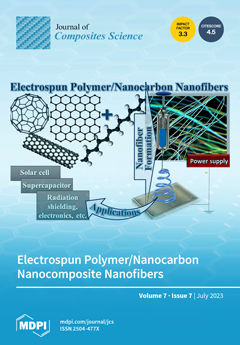The need for an alternative energy source that is both clean and abundant has led to research into a hydrogen economy. Hydrogen gas can be produced slowly via the hydrolysis of sodium borohydride (NaBH
4). A catalyst can be used to speed
[...] Read more.
The need for an alternative energy source that is both clean and abundant has led to research into a hydrogen economy. Hydrogen gas can be produced slowly via the hydrolysis of sodium borohydride (NaBH
4). A catalyst can be used to speed up the rate at which hydrogen is produced, however many catalysts involve relatively expensive materials like precious metals. This study explores a novel copper nanoparticle supported on a graphene-like material composite as a catalyst for the hydrolysis of NaBH
4. The material was characterized via powdered X-ray diffraction (P-XRD), Fourier transform infrared spectroscopy (FTIR), transmission electron microscope (TEM), and Energy Dispersive spectroscopy (EDS). The P-XRD confirmed the crystallinity structures of graphene-like material (GLM) and copper nanoparticles supported over graphene-like material (CuGLM). The P-XRD spectra indicated the (110), (111), and (200) lattice planes of copper nanoparticles. In FTIR analysis, the shifted and sharpening functional group peaks were observed when copper nanoparticles were supported by the GLM template. The TEM result indicated that the copper nanoparticle had a size of approximately 10 nm. The catalyst (CuGLM) was tested under different doses of NaBH
4, solution pH, and reaction temperatures. Temperature data were used to determine the activation energy of the reaction to be 46.8 kJ mol
−1, which is competitive when compared to similar catalysts. The catalyzed reaction generated the highest volume of hydrogen at pH 8 (51 mL), 303 K (32 mL), and 1225 μmol of NaBH
4 (37 mL). The catalyst was found to be able to be used multiple times in succession without any significant loss in hydrogen generated. This catalyst is an exciting option for the sustainable generation of hydrogen gas as a fuel source.
Full article





